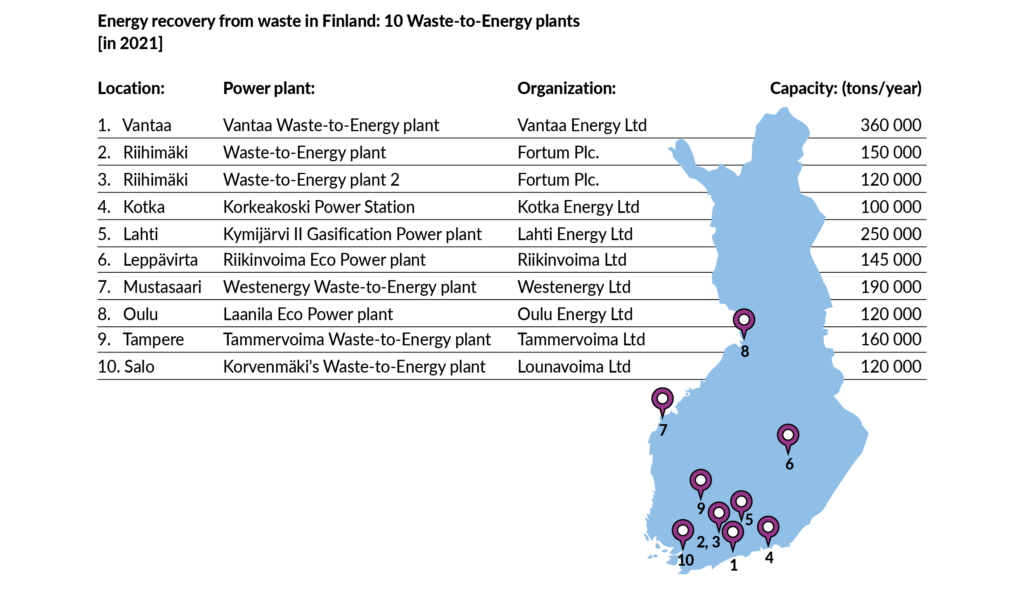Waste-to-energy solutions
In Finland as well as in most of Western European countries waste-to-energy (waste incineration plant with energy recovery) plays a very significant role in municipal waste management. Waste-to-energy plants are usually CHP (combined heat and power) plants that can generate electricity and district heating. Waste-to-energy plants produce around 1% of Finland’s electricity production and around 8-10% of district heating production, depending on the annual heating demand of properties and variations in winter weather. In addition to municipal mixed waste, waste-to-energy plants also incinerate industrial and construction waste. It is estimated that municipal mixed waste accounts for about 70% of the total capacity.
Finnish waste-to-energy plants are the most modern in Europe. In 2021, there are ten waste-to-energy power plants operating in Finland with a total capacity of approximately 1.9 Mt/a (Figure 64). One of the existing plants is currently expanding and is scheduled to be commissioned in Autumn 2022.

Most of Finland’s waste-to-energy plant capacity is under municipal control. There are several different models by which waste-to-energy plants are owned and operated:
- There are four municipal energy companies:
- KotkanEnergia
- Lahti Energia
- OulunEnergia
- VantaanEnergia (city of Vantaa owns 60% and city of Helsinki 40%)
- The biggest plant owner in Finland is the government-controlled energy company Fortum Plc. which also treats hazardous waste and generates energy from it. Fortum’s largest owner is the Finnish state with a share of almost 51 percent.
- The third form is a joint venture of an MWMO and an energy company, as is in the case of Tammervoima, Lounavoima.
- The fourth form of plant ownership is a joint venture of several MWMOs together or jointly with an energy company:
- Westenergy owned by six MWMOs
- Riikinvoima owned by eight MWMOs and Varkauden Aluelämpö Ltd.
In addition, more than 20 conventional power plants have a license to co-incinerate waste derived fuels, like a variety of solid fuels prepared from municipal, construction and industrial waste (SRF= Solid Recovered Fuel; RDF = Reduce Derived Fuel; REF = Recovered fuel). Also, waste derived fuels can be co-fired in cement kilns. Today less than 10 plants are co-incinerating waste derived fuel.
Waste incineration and its emissions are subject to strict regulation in Finland. Incineration is regulated by the Waste Incineration Regulation, which is based on the EU Industrial Emissions and environmental permits for plants and their control ensure that waste incineration plants do not cause significant environmental and health damage. BAT (best available technologies) conclusions have been drawn up at EU level for waste incineration which set e.g. emission levels for airborne emissions and monitoring requirements. BAT conclusions for waste incineration are renewed approximately every 10 years. The emissions of co-incineration are also strictly regulated and are based on the share of co-fired waste.

